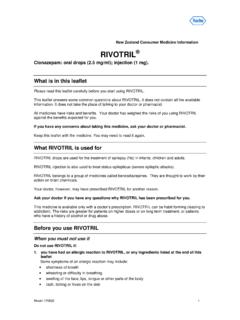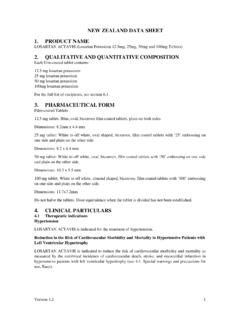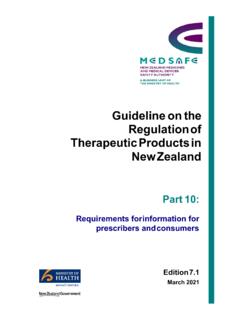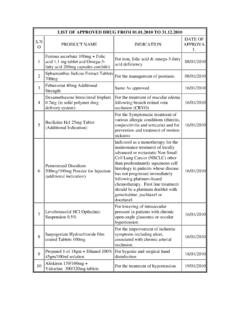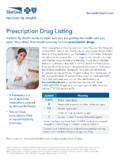Transcription of NEW ZEALAND DATA SHEET - Medsafe
1 NEW ZEALAND DATA SHEET 1 Hypnovel 170717 1. PRODUCT NAME Hypnovel tablets 2. QUALITATIVE AND QUANTITATIVE COMPOSITION Active ingredient: midazolam as the maleate Tablets containing midazolam maleate equivalent to mg of midazolam. For the full list of excipients, see section 3. PHARMACEUTICAL FORM Tablet Midazolam tablets are white, oval, cylindrical, biconvex. Imprint above is ROCHE and below is a single break bar. Dimensions of the tablets are length , width , thickness 4. CLINICAL PARTICULARS Therapeutic indications Adults Short-term treatment of insomnia. Benzodiazepines are only indicated when the disorder is severe, disabling or subjecting the individual to extreme distress. Sedation in premedication before surgical or diagnostic procedures. Dose and method of administration In order to minimise the risk of dependence, benzodiazepines should only be prescribed after careful consideration of the indication and should be taken for the shortest possible duration.
2 Generally the duration of treatment varies from a few days to a maximum of 2 weeks. Treatment with Hypnovel should not be terminated abruptly. The tapering-off process should be tailored to the individual. The necessity of continuing treatment should be closely monitored. In certain cases extension beyond the maximum treatment period may be necessary; if so, it should not take place without re-evaluation of the patient s status. Dose The standard dosage range: mg. NEW ZEALAND DATA SHEET 2 Hypnovel 170717 Treatment should be started with the lowest recommended dose. The maximum dose should not be exceeded because of the increased risk of CNS adverse effects possibly including clinically relevant respiratory and cardiovascular depression. Premedication Adults In premedication, 15mg of Hypnovel should be given 30-60 minutes before the procedure.
3 Special populations Elderly and/or debilitated patients In elderly and/or debilitated patients the recommended dose is mg. In elderly patients, Hypnovel showed a larger sedative effect; therefore they may be at increased risk of cardio-respiratory depression as well. Thus, Hypnovel should be used very carefully in elderly patients, and if needed, a lower dose should be considered. Renal impairment There is a greater likelihood of adverse drug reactions in patients with severe kidney disease. In patients with severe renal impairment, Hypnovel may be accompanied by more pronounced and prolonged sedation possibly including clinically relevant respiratory and cardiovascular depression. Hypnovel should therefore be dosed carefully in this patient population and titrated for the desired effect. The lowest dose should be considered, not exceeding mg (see section , Pharmacokinetics in Special Populations).
4 Hepatic impairment Patients with severe hepatic impairment should not be treated with Hypnovel tablets (see section ). In patients with mild to moderate hepatic impairment, the lowest dose possible should be considered, not exceeding mg (see section , Pharmacokinetics in Special Populations). Paediatric Populations Hypnovel tablets should not be given to children 12 years of age and under, because the available tablet strength does not allow for appropriate dosing in this patient population (see section ). Method of administration Owing to the rapid onset of action, Hypnovel tablets should be taken immediately before going to sleep, and swallowed whole with fluid. Hypnovel can be taken at any time of the day, provided the patient is subsequently assured of at least 7-8 hours undisturbed sleep. Contraindications Hypnovel must not be used in patients with severe respiratory insufficiency; NEW ZEALAND DATA SHEET 3 Hypnovel 170717 severe hepatic impairment (benzodiazepines are not indicated to treat patients with severe hepatic impairment as they may cause encephalopathy), sleep apnoea syndrome; known hypersensitivity to benzodiazepines or to any component of the product; myasthenia gravis.
5 Hypnovel tablets should not be given to children, 12 years of age and under, because the available strength of tablets does not allow for appropriate dosing in this patient population Hypnovel tablets should not be given to patients receiving concomitant therapy with very strong CYP3A inducers or inhibitors (ketoconazole, itraconazole, voriconazole, HIV protease inhibitors including ritonavir boosted formulations and the HCV protease inhibitors boceprevir and telaprevir (see section ). Special warnings and precautions for use General Information should be given to patients about warnings and precautions pertaining to Hypnovel. Tolerance Some loss of efficacy to the hypnotic effects of short-acting benzodiazepines may develop after repeated use for a few weeks. Duration of treatment The duration of treatment with benzodiazepine hypnotics should be as short as possible (see section ), and should not exceed 2 weeks.)
6 The tapering-off process should be tailored to the individual. Extension beyond this period should not take place without re-evaluation of the situation. It may be useful to inform the patient when treatment is started that it will be of limited duration and to explain precisely how the dosage will be progressively decreased. Moreover it is important that the patient should be aware of the possibility of rebound phenomena, thereby minimising anxiety over such symptoms should they occur while the medicinal product is being discontinued. There are indications that, in the case of benzodiazepines with a short duration of action, withdrawal phenomena can become manifest within the dosage interval, especially when the dosage is high. Rebound insomnia When discontinuing Hypnovel therapy, insomnia may reoccur, possibly with a higher severity than before starting treatment ( rebound insomnia ).
7 Rebound insomnia, a transient syndrome, may be accompanied by other reactions including mood changes, anxiety and restlessness. The risk of rebound phenomena is greater after abrupt discontinuation of treatment. Therefore it is recommended that the dosage of Hypnovel is decreased gradually (see section Medicine Abuse and Dependence). NEW ZEALAND DATA SHEET 4 Hypnovel 170717 Amnesia Hypnovel may cause anterograde amnesia which occurs most frequently within the first few hours after ingesting the product. In order to reduce the risk, patients should ensure that they are able to have an uninterrupted sleep of 7-8 hours. Residual effects Provided the oral dose of Hypnovel is not larger than 15 mg/day and the patient is assured of at least 7 to 8 hours undisturbed sleep, no residual effect is observed following oral administration of Hypnovel tablet in standard patients as confirmed by clinical observations using sensitive pharmacological methods.
8 Depression Pre-existing depression may be unmasked during therapeutic use and withdrawal of benzodiazepine therapy. Benzodiazepines should not be used alone to treat depression or anxiety associated with depression as suicide may occur in such patients. Psychiatric and 'paradoxical' reactions Paradoxical reactions such as restlessness, agitation, irritability, aggressiveness, anxiety and more rarely, delusion, anger, nightmares, hallucinations, psychosis, inappropriate behaviour and other adverse behavioural effects are known to occur when using benzodiazepines. Should this be so, use of the medicine should be discontinued. These effects are more likely to occur in the elderly. Specific patient groups In elderly and/or debilitated patients, as well as in patients with respiratory or cardiovascular impairment, the recommended dose is mg.
9 These patients may be more sensitive to the clinical side effects of midazolam like cardio-respiratory depression. Thus Hypnovel should be used very carefully in these patient populations and if needed a lower dose should be considered (see section Special Populations). Dosage instructions for patients with hepatic and/or renal impairment are described in section Special Populations Benzodiazepines are not recommended for the primary treatment of psychotic illness. Benzodiazepines should not be used alone to treat depression or anxiety associated with depression as suicide may occur in such patients. Concomitant use of alcohol/CNS depressants The concomitant use of Hypnovel with alcohol or/and CNS depressants should be avoided. Such concomitant use has the potential to increase the clinical effects of Hypnovel possibly including severe sedation that could result in coma or death clinically relevant respiratory and/or cardio-vascular depression (see section ).
10 NEW ZEALAND DATA SHEET 5 Hypnovel 170717 Medical history of alcohol or drug abuse Hypnovel should be avoided in patients with a medical history of alcohol or drug abuse. Risks from Concomitant Use with Opioids Concomitant use of benzodiazepines, including Hypnovel, and opioids may result in profound sedation, respiratory depression, coma, and death. Because of these risks, reserve concomitant prescribing of benzodiazepines and opioids for use in patients for whom alternative treatment options are inadequate. Observational studies have demonstrated that concomitant use of opioid analgesics and benzodiazepines increases the risk of drug -related mortality compared to use of opioids alone. If a decision is made to prescribe Hypnovel concomitantly with opioids, prescribe the lowest effective dosages and minimum durations of concomitant use, and follow patients closely for signs and symptoms of respiratory depression and sedation.
